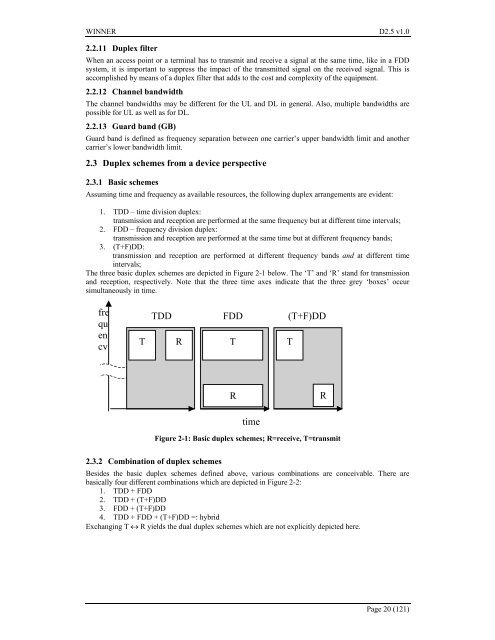IST-2003-507581 WINNER D2.5 v1.0 Duplex ... - Celtic-Plus
IST-2003-507581 WINNER D2.5 v1.0 Duplex ... - Celtic-Plus
IST-2003-507581 WINNER D2.5 v1.0 Duplex ... - Celtic-Plus
- No tags were found...
Create successful ePaper yourself
Turn your PDF publications into a flip-book with our unique Google optimized e-Paper software.
<strong>WINNER</strong> <strong>D2.5</strong> <strong>v1.0</strong>2.2.11 <strong>Duplex</strong> filterWhen an access point or a terminal has to transmit and receive a signal at the same time, like in a FDDsystem, it is important to suppress the impact of the transmitted signal on the received signal. This isaccomplished by means of a duplex filter that adds to the cost and complexity of the equipment.2.2.12 Channel bandwidthThe channel bandwidths may be different for the UL and DL in general. Also, multiple bandwidths arepossible for UL as well as for DL.2.2.13 Guard band (GB)Guard band is defined as frequency separation between one carrier’s upper bandwidth limit and anothercarrier’s lower bandwidth limit.2.3 <strong>Duplex</strong> schemes from a device perspective2.3.1 Basic schemesAssuming time and frequency as available resources, the following duplex arrangements are evident:1. TDD – time division duplex:transmission and reception are performed at the same frequency but at different time intervals;2. FDD – frequency division duplex:transmission and reception are performed at the same time but at different frequency bands;3. (T+F)DD:transmission and reception are performed at different frequency bands and at different timeintervals;The three basic duplex schemes are depicted in Figure 2-1 below. The ‘T’ and ‘R’ stand for transmissionand reception, respectively. Note that the three time axes indicate that the three grey ‘boxes’ occursimultaneously in time.frequencyTDD FDD (T+F)DDT R TTRRtimeFigure 2-1: Basic duplex schemes; R=receive, T=transmit2.3.2 Combination of duplex schemesBesides the basic duplex schemes defined above, various combinations are conceivable. There arebasically four different combinations which are depicted in Figure 2-2:1. TDD + FDD2. TDD + (T+F)DD3. FDD + (T+F)DD4. TDD + FDD + (T+F)DD =: hybridExchanging T ↔ R yields the dual duplex schemes which are not explicitly depicted here.Page 20 (121)
















